Distributed Event-Triggered Current Sharing Consensus-Based Adaptive Droop Control of DC Microgrid
Abstract
:1. Introduction
- Hybrid Event-Triggered Protocol: A novel triggering function) combines state-dependent errors, time-decaying terms, and dynamic coupling weights to eliminate Zeno behavior and reduce communication by 99.975% compared to periodic schemes. Rigorous Lyapunov analysis proves global asymptotic stability without requiring Laplacian eigenvalues, enabling a topology-agnostic operation.
- Dynamic Droop Compensation: Consensus-driven slope adaptation: Secondary control iteratively adjusts droop coefficients via PI-regulated consensus errors, achieving proportional current sharing with <0.015% error under varying line impedances. Voltage intercept compensation: A PI controller eliminates steady-state voltage deviations by dynamically tuning ΔUi.
- Backward-Compatible Design: The protocol’s time-varying coupling weights and local triggering conditions enable seamless integration with legacy droop-controlled inverters, avoiding layer conflicts. Transitional stability during phased deployments is ensured through hybrid Lyapunov functions, as validated in fault scenarios.
2. DC Microgrid Hierarchical Control
2.1. Conventional Droop Control and Its Limitations
2.2. DC Microgrid Hierarchical Control Architecture
- Primary control: Local droop control and voltage/current loops for power sharing and stabilization.
- Secondary control: Consensus-driven compensation of droop coefficients (ΔKi) and voltage deviations (ΔUi).
- Event-triggered consensus control: Adaptive protocols to minimize communication pressure.
3. Event-Triggered Current Sharing Consensus Control
3.1. Event-Triggered Conformance Protocol Design
3.2. Stability Analysis of Event-Triggered Mechanism
3.3. Feasibility Analysis of Event Triggered Mechanism
4. Simulation Verification
4.1. Effect of Hierarchical Control of Load Changes
4.2. Simulation Analysis of Transformer Failures
4.3. Communications Cost Analysis
5. Conclusions
- Hybrid Trigger Function: Combining state-dependent errors and time-decaying terms to exclude Zeno behavior while minimizing communication.
- Topology-Independent Design: Time-varying coupling weights enable fully distributed control without global Laplacian eigenvalues.
- Dynamic Compensation: Adaptive droop coefficients (ΔKi) and voltage intercepts (ΔUi) counteract line impedance effects.
- Backward Compatibility with Traditional Droop Control: To facilitate real-world adoption, we will design threshold-only trigger functions for legacy inverters and analyze hybrid stability during phased upgrades [14].
- Large-Scale Heterogeneous Systems: Extending the protocol to 50+-agent microgrids with PV, wind, and storage via virtual impedance matching.
- Delay and Topology Adaptability: Developing delay-compensated triggers and sparse-topology weights for rural grids.
- Cost-Effective Deployment: Optimizing dynamic compensation (ΔKi) for legacy systems without hardware upgrades.
Author Contributions
Funding
Conflicts of Interest
References
- Shahidehpour, M.; Zhou, Q.; Tian, Z.; Liu, X.; Alabdulwahab, A.; Abusorrah, A. Optimal consensus-based distributed control strategy for coordinated operation of networked microgrids. IEEE Trans. Power Syst. 2019, 35, 2452–2462. [Google Scholar]
- Zhao, H.; Qian, J.; Pan, H.; Jia, L. Adaptive voltage droop control of DC microgrid for island photovoltaic and energy storage. J. North China Electr. Power Univ. (Nat. Sci. Ed.) 2024, 51, 1–11. Available online: https://link.cnki.net/urlid/13.1212.TM.20240424.0959.002 (accessed on 21 July 2024).
- Anand, A.; Ranjan, A.; Devassy, S.; Verma, B.K.; Ram, S.K.; Dhakar, A.K. Review of hierarchical control strategies for DC microgrid. IET Renew. Power Gener. 2020, 14, 1631–1640. [Google Scholar]
- Ning, X.; Pan, H.; Li, F.; Wu, J. An improved droop control strategy for a DC microgrid based on online resistance observations. Power Syst. Prot. Control 2024, 52, 42–51. [Google Scholar]
- Lu, X.; Guerrero, J.M.; Sun, K.; Vasquez, J.C. An improved droop control method for DC microgrids based on low bandwidth communication with DC bus voltage restoration and enhanced current distribution accuracy. IEEE Trans. Power Electron. 2014, 29, 1800–1812. [Google Scholar] [CrossRef]
- Wan, X.; Wu, J. Distributed hierarchical control for islanded microgrids based on adjustable power consensus. Electronics 2022, 11, 324. [Google Scholar] [CrossRef]
- Mo, Z.; Sun, L. Research on SOC equalization control strategy of distributed energy storage considering line impedance. Electr. Power 2024, 121, 439. [Google Scholar]
- Dehkordi, N.M.; Sadati, N.; Hamzeh, M. Fully distributed cooperative secondary frequency and voltage control of islanded microgrids. IEEE Trans. Energy Convers. 2017, 32, 675–685. [Google Scholar] [CrossRef]
- Xia, C.; Shi, M.; Zhou, J.; Zuo, W.; Chen, Y.; Wen, J.; He, H. Consensus-based distributed control for photovoltaic-battery units in a DC microgrid. IEEE Trans. Ind. Electron. 2019, 66, 7778–7787. [Google Scholar]
- Zhou, Q.; Shahidehpour, M.; Li, Z.; Che, L.; Alabdulwahab, A.; Abusorrah, A. Compartmentalization strategy for the optimal economic operation of a hybrid AC/DC microgrid. IEEE Trans. Power Syst. 2020, 35, 1294–1304. [Google Scholar] [CrossRef]
- Wang, B.; Wang, Y.; Xu, Y.; Zhang, X.; Gooi, H.B.; Ukil, A.; Tan, X. Consensus-based control of hybrid energy storage system with a cascaded multiport converter in DC microgrids. IEEE Trans. Sustain. Energy 2019, 11, 2356–2366. [Google Scholar] [CrossRef]
- Al-Tameemi, Z.H.A.; Lie, T.T.; Foo, G.; Blaabjerg, F. Optimal coordinated control strategy of clustered DC microgrids under load-generation uncertainties based on GWO. Electronics 2022, 11, 1244. [Google Scholar] [CrossRef]
- Zeng, H.; Zhao, E.; Zhou, S.; Han, Y.; Yang, P.; Wang, C. Adaptive droop control of a DC microgrid based on current consistency. Power Syst. Prot. Control 2022, 50, 11–21. [Google Scholar]
- Huang, S.; Xiong, L.; Zhou, Y.; Gao, F.; Jia, Q.; Li, X.; Li, X.; Wang, Z.; Khan, M.W. Robust distributed fixed-time fault-tolerant control for shipboard microgrids with actuator fault. IEEE Trans. Transp. Electrific. 2024, 11, 1791–1804. [Google Scholar] [CrossRef]
- Ding, L.; Han, Q.; Ge, X.; Zhang, X.-M. An overview of recent advances in event-triggered consensus of multiagent systems. In Proceedings of the IEEE Conference on Cybernetics, Shenzhen, China, 10–12 December 2018; pp. 1110–1123. [Google Scholar]
- Chen, P.; Han, Q. On designing a novel self-triggered sampling scheme for networked control systems with data losses and communication delays. IEEE Trans. Ind. Electron. 2016, 63, 1239–1248. [Google Scholar]
- Abhinav, S.; Modares, H.; Lewis, F.L.; Davoudi, A. Resilient cooperative control of DC microgrids. IEEE Trans. Smart Grid 2019, 10, 1083–1085. [Google Scholar] [CrossRef]
- Chen, M.; Xiao, X.; Guerrero, J.M. Secondary restoration control of islanded microgrids with a decentralized event-triggered strategy. IEEE Trans. Ind. Inform. 2018, 14, 3870–3880. [Google Scholar] [CrossRef]
- Luo, Y.; Chen, M.; Kang, W.; Sun, X. Distributed event-triggered voltage control with limited reactive power in low-voltage distribution networks. Electronics 2021, 10, 128. [Google Scholar] [CrossRef]
- Chen, Z.; Yu, X.; Xu, W.; Wen, G. Modeling and control of islanded DC microgrid clusters with hierarchical event-triggered consensus algorithm. IEEE Trans. Circuits Syst. I 2021, 68, 376–386. [Google Scholar] [CrossRef]
- Peng, J.; Fan, B.; Tu, Z.; Zhang, W.; Liu, W. Distributed periodic event-triggered optimal control of DC microgrids based on virtual incremental cost. IEEE/CAA J. Autom. Sin. 2022, 9, 624–634. [Google Scholar] [CrossRef]
- Olfati-Saber, R.; Fax, A.J.; Murray, M.R. Consensus and cooperation in networked multi-agent systems. Proc. IEEE 2007, 95, 215–233. [Google Scholar] [CrossRef]
- Cheng, B.; Li, Z. Fully distributed event-triggered protocols for linear multiagent networks. IEEE Trans. Autom. Control 2019, 64, 1655–1662. [Google Scholar] [CrossRef]
- Meng, L.; Dragicevic, T.; Roldan-Perez, J.; Vasquez, J.C.; Guerrero, J.M. Modeling and sensitivity study of consensus algorithm-based distributed hierarchical control for DC microgrids. IEEE Trans. Smart Grid 2016, 7, 1504–1515. [Google Scholar] [CrossRef]
- Augustine, S.; Lakshminarasamma, N.; Mishra, M.K. Control of photovoltaic-based DC microgrid system. IET Power Electron. 2016, 9, 1132–1143. [Google Scholar] [CrossRef]

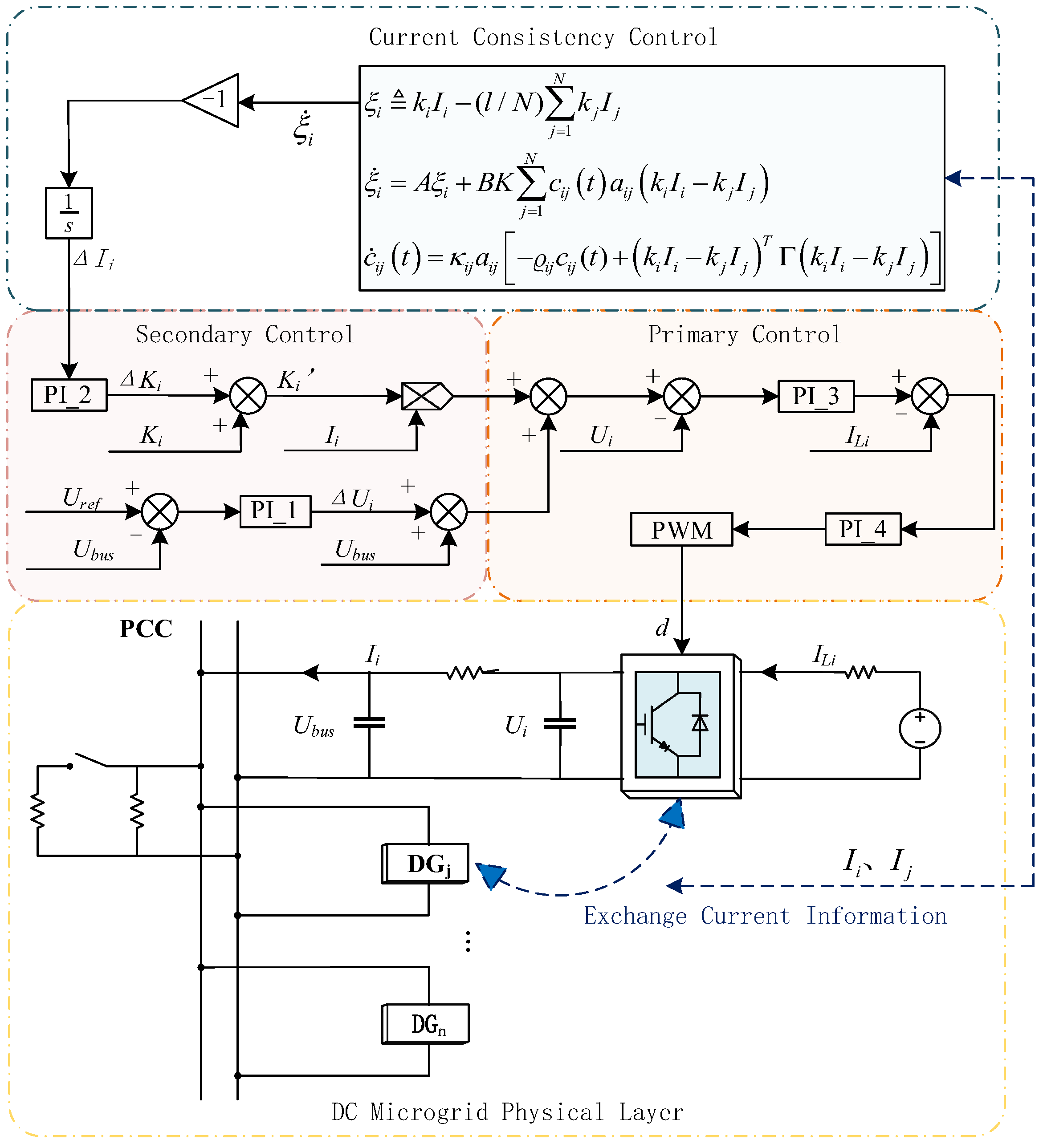
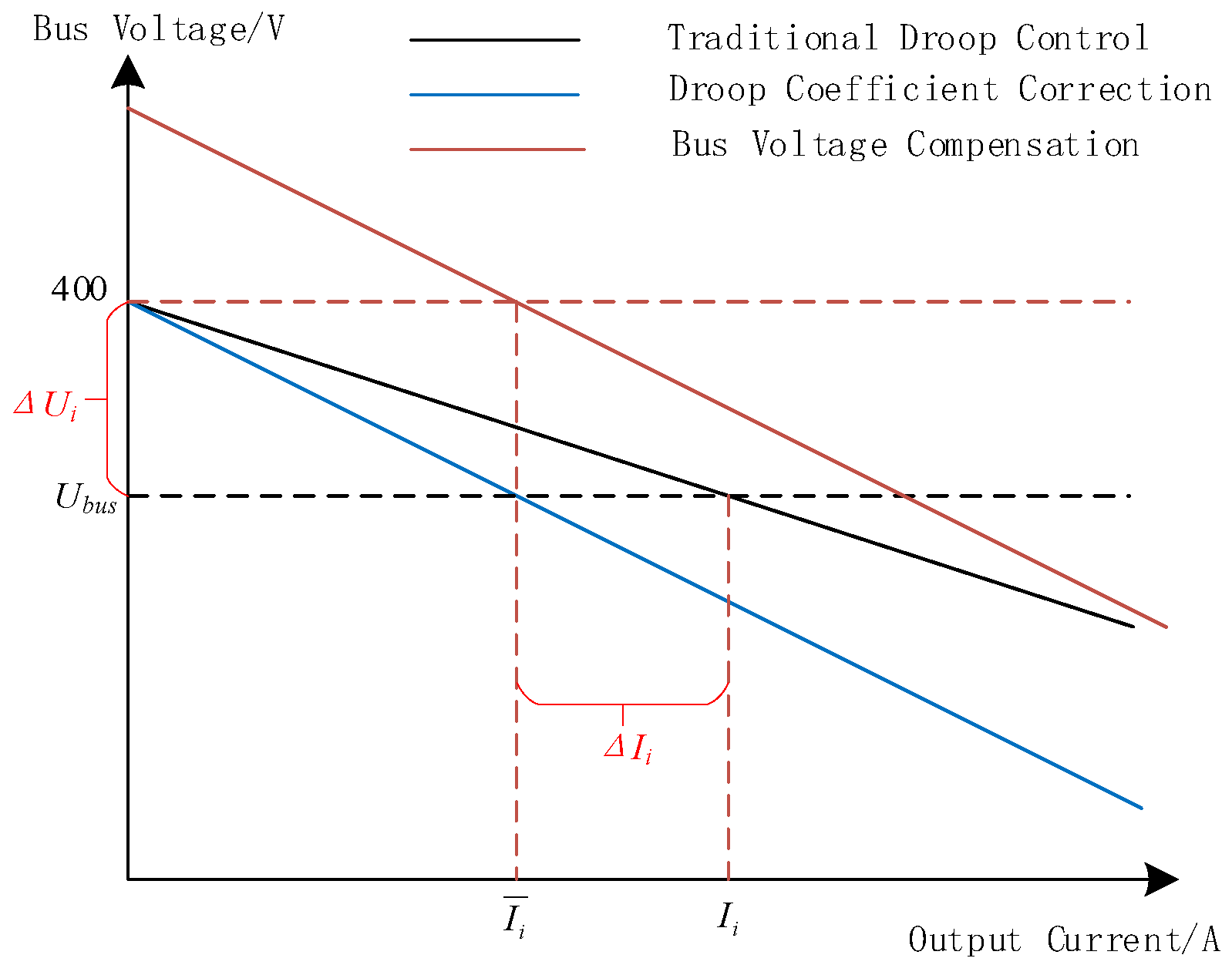
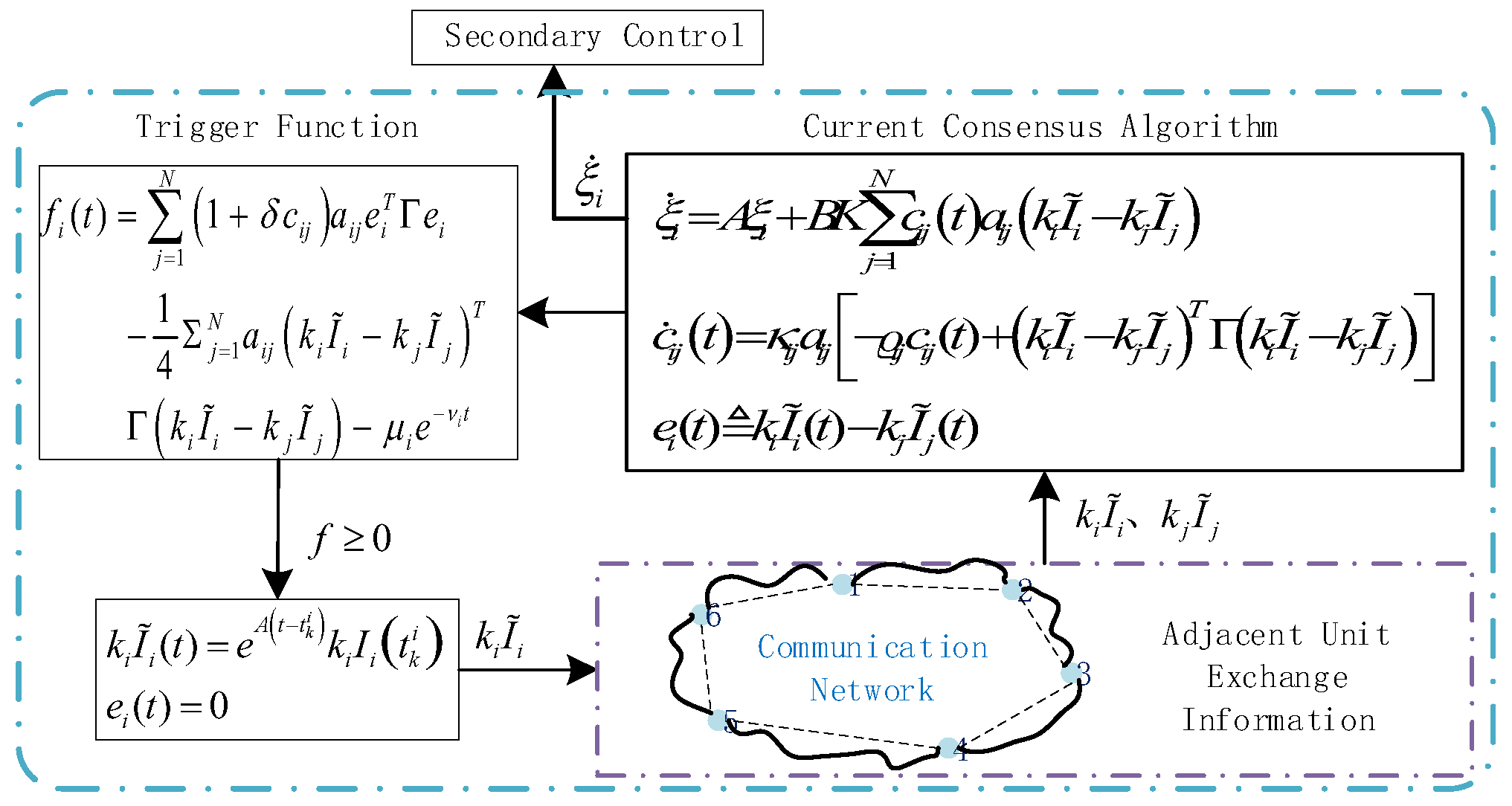





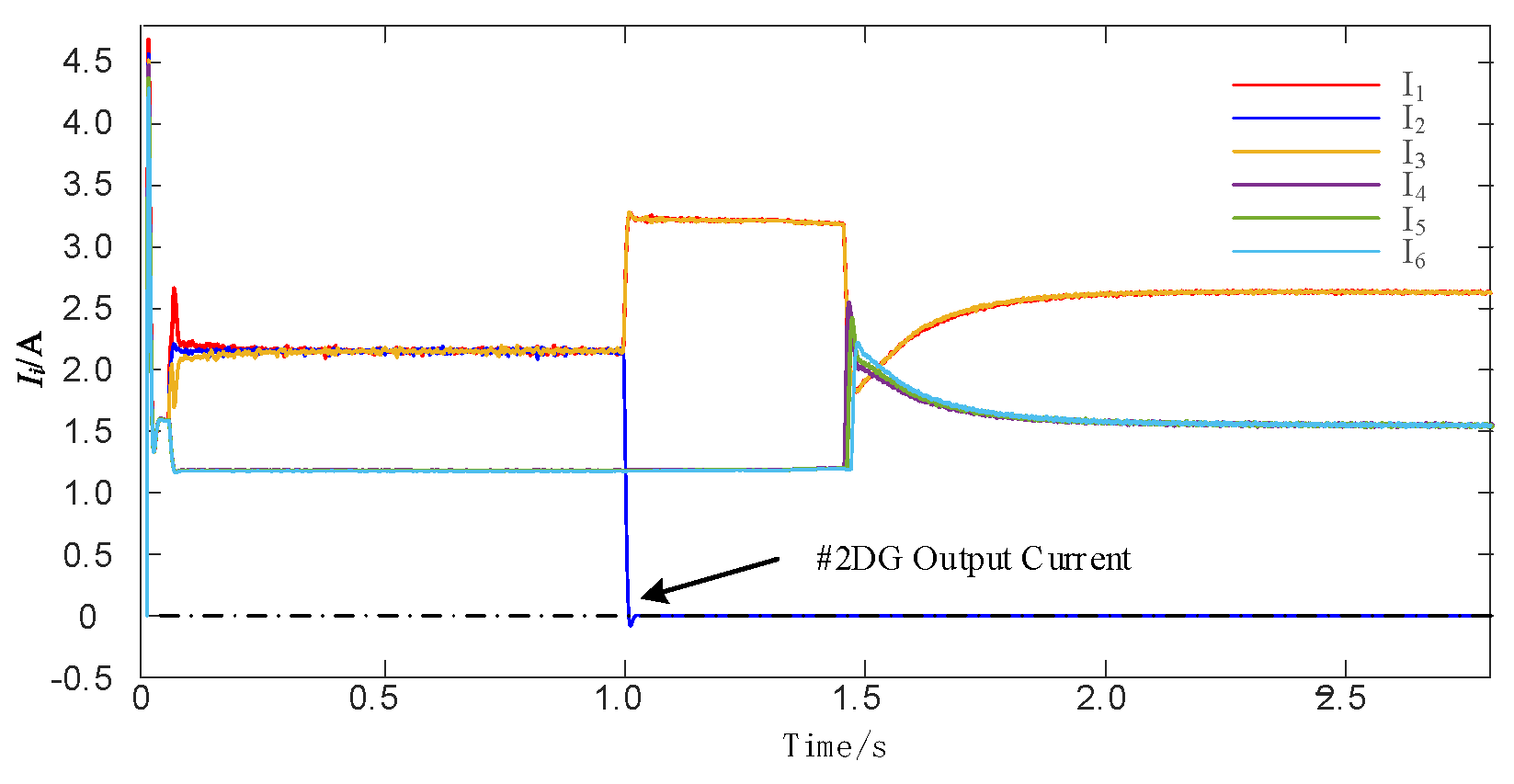
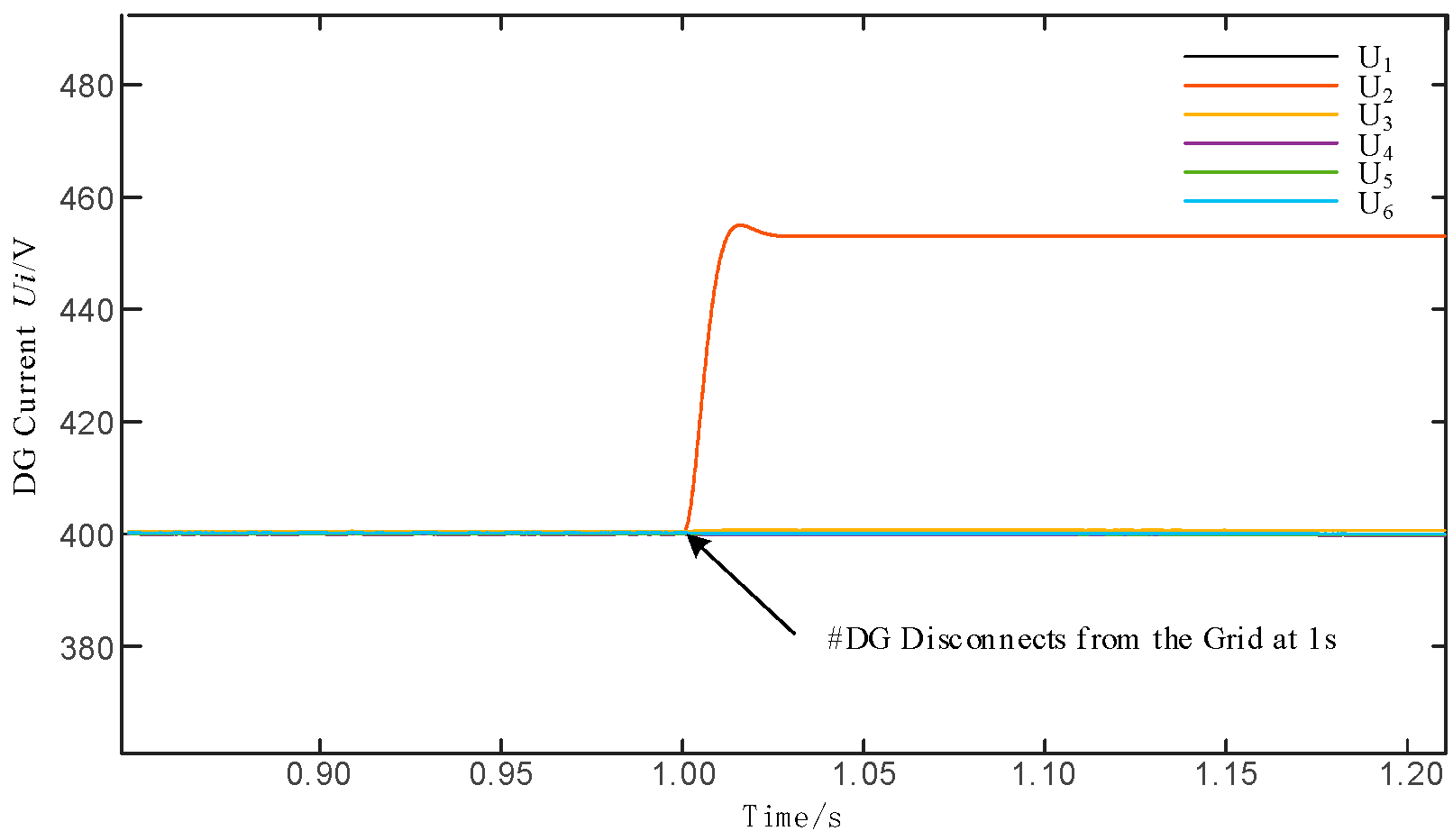


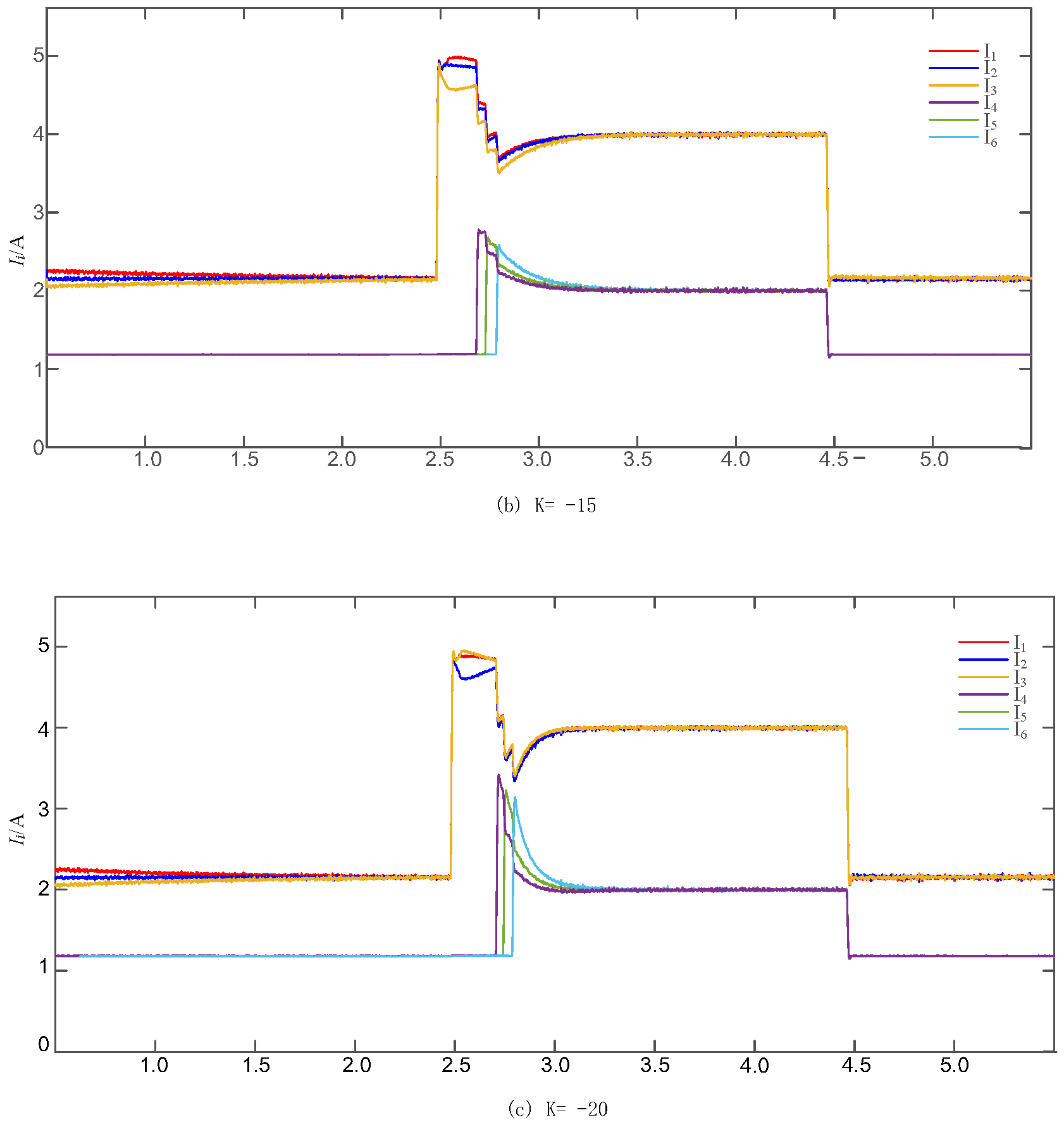
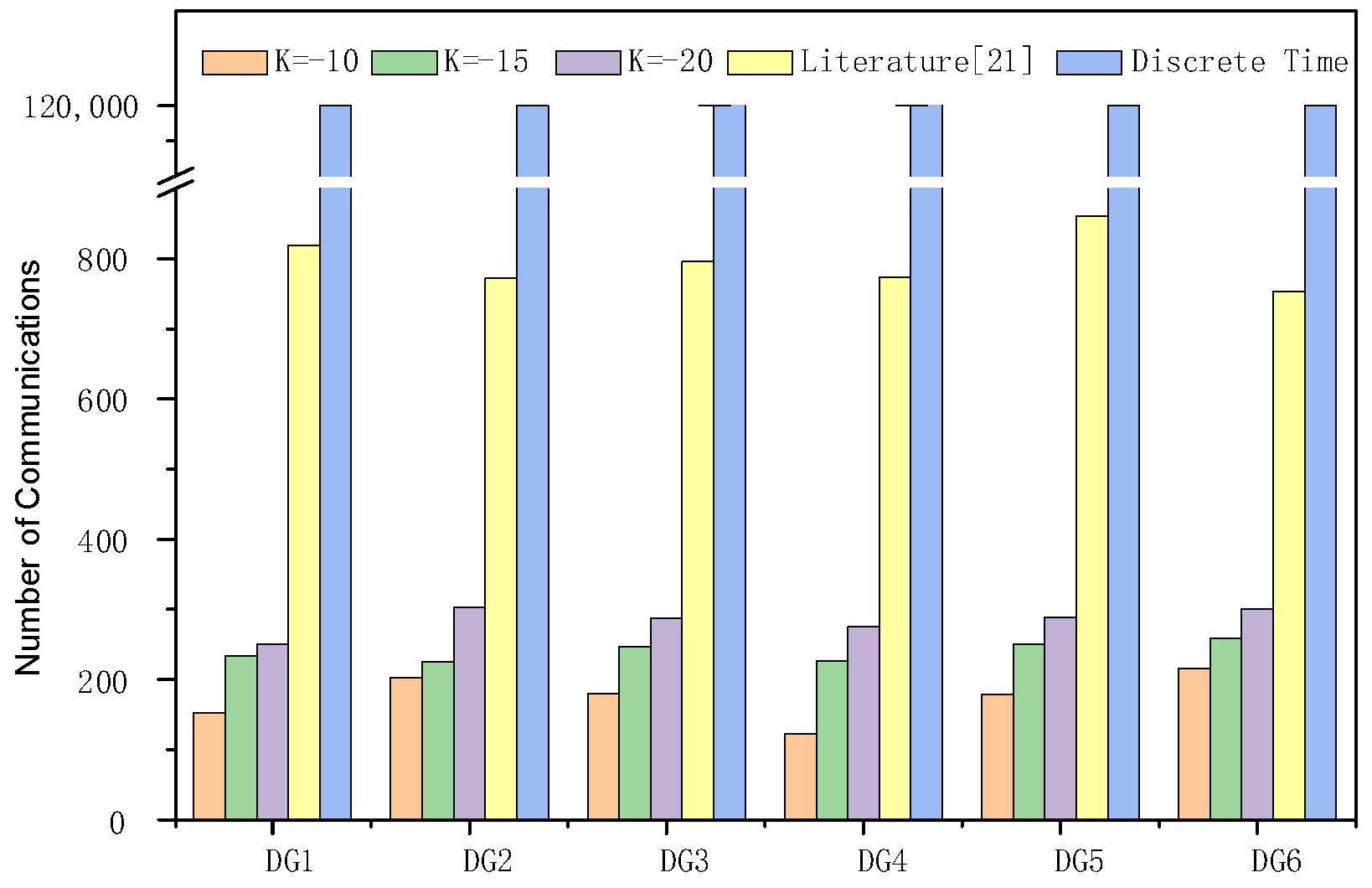
| Parameters | Numerical Value | |
|---|---|---|
| DC microgrids | Busbar voltage rating Uref/V | 400 |
| Power supply output voltage Ubus/V | 200 | |
| Load resistance RL1/Ω | 40 | |
| Load resistance RL2/Ω | 50 | |
| Bus-to-ground capacitance CBG/F | 4 × 10−5 | |
| Transformer capacitance CC/F | 4 × 10−5 | |
| Transformer inductance LC/F | 2 × 10−5 | |
| primary control layer | Carrier frequency fcar/kHz | 10 |
| Voltage loop controller (PI_3) parameters | KP3 = 0.01 | |
| KI3 = 800 | ||
| Current loop controller (PI_4) parameters | KP4 = 500 | |
| KI4 = 30 | ||
| secondary control layer | First PI controller (PI_1) parameters | KP1 = 10.0 |
| KI1 = 0.03 | ||
| Second PI controller (PI_2) parameters | KP2 = 0.05 | |
| KI2 = 0.36 | ||
| Event triggered layer | Feedback gain | |
| 0.0325 | ||
| 0.0025 | ||
| 2 | ||
| 0.001 | ||
| 1 |
| Feature | Proposed Method | Traditional Droop [4] | Consensus [18] | Periodic [21] |
|---|---|---|---|---|
| Current Error | <0.015% | 2.0% | 0.05% | 0.1% |
| Voltage Deviation | 0.09% | 1.5% | 0.2% | 0.3% |
| Communication Events | 300 (6 s) | N/A | 1200 (6 s) | 1.2 M (6 s) |
| Topology Dependency | Fully Distributed | Local Only | Global Eigenvalues | Fixed Intervals |
| Zeno Behavior | Excluded | N/A | Partially Addressed | Not Addressed |
Disclaimer/Publisher’s Note: The statements, opinions and data contained in all publications are solely those of the individual author(s) and contributor(s) and not of MDPI and/or the editor(s). MDPI and/or the editor(s) disclaim responsibility for any injury to people or property resulting from any ideas, methods, instructions or products referred to in the content. |
© 2025 by the authors. Licensee MDPI, Basel, Switzerland. This article is an open access article distributed under the terms and conditions of the Creative Commons Attribution (CC BY) license (https://creativecommons.org/licenses/by/4.0/).
Share and Cite
Zeng, J.; Liu, T.; Xu, C.; Sun, Z. Distributed Event-Triggered Current Sharing Consensus-Based Adaptive Droop Control of DC Microgrid. Electronics 2025, 14, 1217. https://doi.org/10.3390/electronics14061217
Zeng J, Liu T, Xu C, Sun Z. Distributed Event-Triggered Current Sharing Consensus-Based Adaptive Droop Control of DC Microgrid. Electronics. 2025; 14(6):1217. https://doi.org/10.3390/electronics14061217
Chicago/Turabian StyleZeng, Jinhui, Tianqi Liu, Chengjie Xu, and Zhifeng Sun. 2025. "Distributed Event-Triggered Current Sharing Consensus-Based Adaptive Droop Control of DC Microgrid" Electronics 14, no. 6: 1217. https://doi.org/10.3390/electronics14061217
APA StyleZeng, J., Liu, T., Xu, C., & Sun, Z. (2025). Distributed Event-Triggered Current Sharing Consensus-Based Adaptive Droop Control of DC Microgrid. Electronics, 14(6), 1217. https://doi.org/10.3390/electronics14061217






